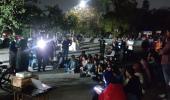In Kerala, the use of black ranges from convenience to strictures by community and religion to fashion and personal choice.
One would have to be really insecure or too fond of the well settled life to see black solely as a badge of protest, points out Shyam G Menon.

February 19, 2023. Kerala's saga of engagements with black, added another chapter.
That day, according to The News Minute, a government college in Kozhikode where the state's chief minister Pinarayi Vijayan was due to participate in a function issued a guideline to students that they should refrain from wearing black masks and clothes.
At least one news channel, known to nurse a pro Right Wing stance, secured confirmation from college authorities that they issued the guideline after a prompt from the police.
On its part, the police, as per the Mathrubhumi Web site, denied any such role.
The Web site also reported that a police complaint was filed on the matter.
The controversy around black is not new.
In June 2022, when protests erupted in Kerala over disclosures in a controversial gold smuggling case, a related report that year (dated June 12) in the Hindustan Times newspaper said, 'For the second consecutive day, media persons to common people wearing black masks, shirts or other dresses were allegedly barred from public programmes being attended by the CM.'
On June 14, 2022, The New Indian Express newspaper reported that the chief minister in a video message had said there was a false campaign around black clothes and masks not being allowed in Kerala.
The latest edginess of the Left Democratic Front government can be easily comprehended.
The state's Economic Review, presented in the assembly on February 2, mentioned that while there were positive elements about the state's economy and tax collection, it cannot afford any laxity in revenue mobilisation because state expenditure had risen.
That may be putting it diplomatically. The general perception is that Kerala is on a very slippery slope financially.
Events ranging from the floods of 2018 to the months of the COVID-19 pandemic and lockdown, have left their impact on state finances.
Add to it, the state's borrowing powers clipped, allegations of financial profligacy and the difficulty of being a state and a government with a different political orientation in an India ruled by an insecure and intolerant Right-Wing Bharatiya Janata Party.
Result -- like Centre, like state; both are zealously defensive.
The mirror image of proclivities in the leadership of both sides hasn't been lost on the state's electorate.
Just like Narendra Modi's recent claim that he alone is enough to tackle a political Opposition of many, the LDF has permitted imagery around Vijayan replete with posters showcasing him as a tough politician, who is not to be messed with.
Both leaders are at the helm of cadre based-parties, which they dominate.
Modi has his Bullet Train. Vijayan has been unsuccessfully pushing for Silver Line.
While the behaviour and positioning of the two may seem similar, there is a major difference as regards context.
A decade after the Modi brand of BJP-rule spread across India from Delhi, much of the country is still debating the relevance of protest and the merit in having a strong political Opposition.
As Hindutva and the complicity of corporate India in Right-Wing domination show, there are sections of the electorate, which agree with the central government's policies notwithstanding complaints of it as socially divisive, majoritarian and domineering, even -- as some critics have stated -- authoritarian.
To that extent, Modi and BJP can hope to repeat their success and excess.

Vijayan's Kerala is different. Whenever the LDF or the Congress-led United Democratic Front won elections, Keralites have celebrated with their take on Asterix and his village defiantly holding out against a Gaul conquered and administered by the Romans (the Romans herein being the BJP).
One reason for this is the intolerant, controlling streak of the BJP and the still undead admiration in Kerala for the independent-minded, which also encompasses in its fold, respect for protest and speaking up against authority.
These are among traits that fetched support for the Left years ago, when the movement was value-based and less rooted in loyalty to organisation.
Today outfits exist in Kerala that seek a socialism that is different from the corporate enterprise, the local CPM has come to resemble.
At the same time, dominance by the remittance economy, return to traditional outlook tracking Kerala's growing prosperity and the ageing of its people; and the ascent of a new generation with roots in consumerism, are changing the state's values.
But the dying admiration for independent perspective, although battered, soldiers on.
Soon after the Economic Review was tabled, on February 3, 2023, the LDF government presented a budget in the state assembly that contained steps (essentially tax measures) capable of escalating prices all around.
On top of already high fuel prices, the government introduced a cess on petrol and diesel, raised the fair value of land and increased electricity tariff.
Plus, it ruffled feathers in the powerful lobby of Non-Resident Indians by imposing a tax on houses left unoccupied.
Expectedly, protests erupted.
A magnet for attack by the Opposition has been a very avoidable act on the part of Vijayan -- his convoy.
Years ago, the late K Karunakaran's white Mercedes Benz, which he used to zip around the state, had evoked both awe and anger.
The image of Vijayan too has become associated with his convoy. Waving black flags before it has become an act of protest, which then gets milked for publicity in a state bombarded by media. Does it fetch anything?

With the public and the courts now disapproving bandhs and hartals, protests in Kerala appear challenged for want of a new, sensible model.
A television grab showed Opposition workers setting fire to a copy of the budget near a petrol pump, oblivious to the danger in the act.
Later, the Opposition converging to protest before the state secretariat in Thiruvananthapuram, left commuters irritated by the blockade of an arterial road.
"As it is, life is difficult. Now, this too," my autorickshaw driver grumbled as we passed by.
The problem in such protest is that aside from the capacity of video to attract eyeballs, it achieves little.
Instead of drawing the government into an informed debate over a budget that has angered many, it gives the government an excuse to avoid addressing the subject citing conspiracy and an Opposition that believes only in perennial protest.
Genuine questions around the budget, genuine grievances -- they remain unanswered.
There is also another danger. Longstanding displays of indiscipline has seen many in Kerala admire the Right-Wing promise of a regimented society as panacea.
This is even more dangerous as that sort of regimentation can suppress independent thinking and protest altogether.
Mid-February, at a public meeting in Vadakara, I would hear an engaging speaker from the Left (not aligned with the CPI-M however), highlight the obtuseness in a society trading the right to protest for abject discipline and compliance.
In the days following the budget, the state's finance minister defended the stiff medicine in the document.
On the night of February 19 (the day black returned to the news), one saw him from a passing train; he was walking on the platform at Kollam railway station, surrounded by a posse of security personnel.
Earlier on the day one saw the finance minister; at Ernakulam's main railway station, the number of people wearing black hadn't been small.
For travelers, black (or any dark shade) is a practical colour because it endures the toll of journeying.
In Kerala, the use of black ranges from such convenience to strictures by community and religion to fashion and personal choice.
One would have to be really insecure or too fond of the well settled life to see black solely as a badge of protest.
On February 20, onmanorama.com reported that among the black flags taken down by the police ahead of Vijayan's visit to Kozhikode was one tied near the house of a former CPI-M legislator who had died a day earlier.
Black flags marking a house in mourning is a common practice in Kerala.
Meanwhile, Youth Congress activists who waved black flags at the chief minister in Kannur were taken into custody.
Wikipedia describes black so: 'Black is a color which results from the absence or complete absorption of visible light.'
That is how science views it. The minds of people interpret black in many prejudiced ways.
Shyam G Menon is a Mumbai-based columnist.
Feature Presentation: Aslam Hunani/Rediff.com










